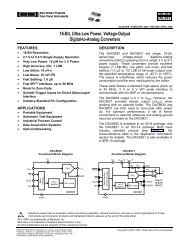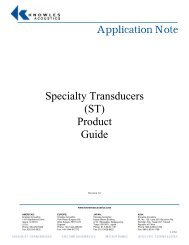AD7714* 3 V/5 V, CMOS, 500 µA Signal Conditioning ADC - dreamm
AD7714* 3 V/5 V, CMOS, 500 µA Signal Conditioning ADC - dreamm
AD7714* 3 V/5 V, CMOS, 500 µA Signal Conditioning ADC - dreamm
You also want an ePaper? Increase the reach of your titles
YUMPU automatically turns print PDFs into web optimized ePapers that Google loves.
AD7714<br />
MD2 MD1 MD0 Operating Mode (continued)<br />
1 0 0 System-Offset Calibration; this activates system-offset calibration on the channel selected by CH2, CH1<br />
and CH0 of the Communications Register. This is a one step calibration sequence and when complete<br />
the part returns to Normal Mode with MD2, MD1 and MD0 returning to 0, 0, 0. The DRDY output<br />
or bit goes high when calibration is initiated and returns low when this system offset calibration is complete<br />
and a new valid word is available in the data register. For this calibration type, the zero-scale calibration<br />
is performed at the selected gain on the input voltage provided at the analog input during this<br />
calibration sequence. This input voltage should remain stable for the duration of the calibration. The<br />
full-scale calibration is performed at the selected gain on an internally generated V REF /Selected Gain.<br />
1 0 1 Background Calibration; this activates background calibration on the channel selected by CH2, CH1<br />
and CH0 of the Communications Register. If the background calibration mode is on, then the AD7714<br />
provides continuous self-calibration of the shorted (zeroed) inputs. This calibration takes place as part<br />
of the conversion sequence, extending the conversion time and reducing the word rate by a factor of six.<br />
Its major advantage is that the user does not have to worry about recalibrating the offset of the device<br />
when there is a change in the ambient temperature or supplies. In this mode, the zero-scale calibration<br />
is performed at the selected gain on internally shorted (zeroed) inputs. The calibrations are interleaved<br />
with normal conversions and the calibration registers of the device are automatically updated. Because<br />
the background calibration does not perform full-scale calibrations, a self-calibration should be performed<br />
before placing the part in the background calibration mode.<br />
1 1 0 Zero-Scale Self-Calibration; this activates zero-scale self-calibration on the channel selected by CH2,<br />
CH1 and CH0 of the Communications Register. This zero-scale self-calibration is performed at the<br />
selected gain on internally shorted (zeroed) inputs. This is a one step calibration sequence and when<br />
complete the part returns to Normal Mode with MD2, MD1 and MD0 returning to 0, 0, 0. The DRDY<br />
output or bit goes high when calibration is initiated and returns low when this zero-scale self-calibration<br />
is complete and a new valid word is available in the data register.<br />
1 1 1 Full-Scale Self-Calibration; this activates full-scale self-calibration on the channel selected by CH2,<br />
CH1 and CH0 of the Communications Register. This full-scale self-calibration is performed at the<br />
selected gain on an internally-generated V REF /Selected Gain. This is a one step calibration sequence and<br />
when complete the part returns to Normal Mode with MD2, MD1 and MD0 returning to 0, 0, 0. The<br />
DRDY output or bit goes high when calibration is initiated and returns low when this full-scale selfcalibration<br />
is complete and a new valid word is available in the data register.<br />
G2 G1 G0 Gain Setting<br />
0 0 0 1<br />
0 0 1 2<br />
0 1 0 4<br />
0 1 1 8<br />
1 0 0 16<br />
1 0 1 32<br />
1 1 0 64<br />
1 1 1 128<br />
BO<br />
FSYNC<br />
Burn-Out Current. A 0 in this bit turns off the on-chip burn-out currents. This is the default (Power-<br />
On or RESET) status of this bit. A 1 in this bit activates the burn-out currents. When active, the burnout<br />
currents connect to the selected analog input pair, one to the AIN(+) input and one to the AIN(–) input.<br />
Filter Synchronization. When this bit is high, the nodes of the digital filter, the filter control logic and<br />
the calibration control logic are held in a reset state and the analog modulator is also held in its reset<br />
state. When this bit goes low, the modulator and filter start to process data and a valid word is available<br />
in 3 × 1/(output update rate), i.e., the settling time of the filter. This FSYNC bit does not affect the<br />
digital interface and does not reset the DRDY output if it is low.<br />
–14–<br />
REV. B















